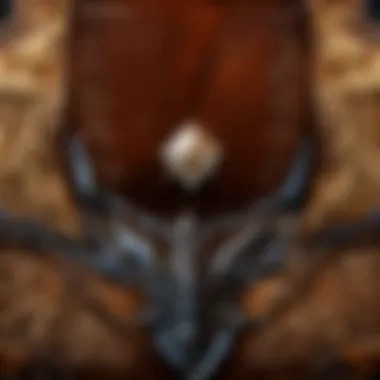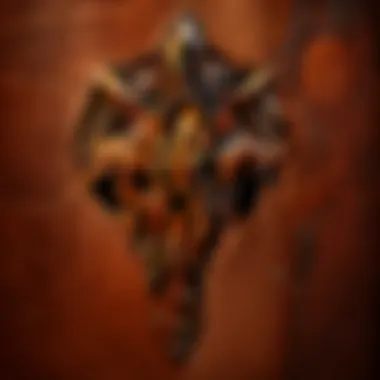Beginning Leatherworking: A Comprehensive Guide


Intro
Leatherworking is a craft that combines artistry and functionality. It offers a satisfying way to create items that are both practical and beautiful. With the right guidance, anyone can learn the fundamentals of this age-old skill. This guide is designed to be an entry point for those who are considering taking up leatherworking. As it unfolds, it will provide insights into essential tools, techniques, and tips for beginners. Essentially, it aims to equip readers with the knowledge to start their leatherworking journey confidently.
Understanding Leatherworking
Leatherworking is not merely about stitching leather pieces together; it is a complex art form that involves various processes. From cutting and dyeing to sewing and finishing, each stage requires attention to detail. The beauty of leather as a material lies in its durability and adaptability. Depending on the project at hand, the type of leather you choose can significantly impact the final product's quality.
"A well-crafted leather item tells a story. Each piece reflects both the creator's skill and the unique characteristics of the leather used."
Ash leather, for example, is known for its natural finish, showcasing unique marks and textures. On the other hand, chrome-tanned leather is often softer and easier to work with, making it a favorite among beginners.
The Relevance of Leatherworking Today
In an age of mass production, leatherworking stands out as a personal, hands-on craft. Many people seek unique, handcrafted items. This trend has given rise to a renewed interest in leatherworking. By learning this skill, individuals can express their creativity while creating functional items. Besides, leatherworking offers a way to create custom pieces that can be tailored to one’s personal style or practical needs.
What to Expect in This Guide
This guide will cover several aspects of leatherworking. You will learn about the essential tools you should consider acquiring. We will explore different types of leather and suitable projects for beginners. Techniques will be discussed, along with common challenges that new leatherworkers face.
Additionally, the guide will provide insight into how to overcome these challenges, helping budding artisans build confidence in their skills. By the end of this guide, readers will have a solid foundation to start their leatherworking projects with clarity and purpose.
Understanding Leatherworking
Understanding leatherworking is crucial for both beginners and enthusiasts. It establishes the foundational knowledge required to delve into this rich and diverse craft. Leatherworking encompasses a variety of techniques, tools, and materials, making it an intricate skill to master. By grasping the basics of leatherworking, individuals can appreciate the artistry and craftsmanship involved in producing functional and aesthetic items.
The benefits of understanding leatherworking extend beyond simple production. For many, it offers a therapeutic outlet, allowing for creativity and problem-solving. Moreover, knowledge of leatherworking opens up opportunities for customization, making unique items that reflect personal style. It also fosters a connection to the history of this craft, which dates back thousands of years.
Incorporating leatherworking into one’s skill set can lead to practical advantages. Whether creating gifts or self-made personal items, it provides a sense of accomplishment that comes from tangible results. By learning the principles of leatherworking, a beginner can avoid common pitfalls, improve efficiency, and achieve higher-quality results.
What is Leatherworking?
Leatherworking is the art and craft of creating items from leather. It involves a multitude of techniques, including cutting, stitching, and finishing, to transform raw hides into functional and aesthetically appealing goods. These goods can range from everyday items like wallets and belts to more intricate pieces, such as handbags and outdoor gear. The process can be intricate or simple, depending on the design and techniques used.
Leatherworking requires specific tools and materials, with a range of approaches suited to different projects. Understanding these basics lays the foundation for any leatherworker, enabling the transition from novice to skilled artisan.
Historical Context of Leatherworking
The history of leatherworking is rich and varied, tracing back to ancient civilizations. This craft played a vital role in the development of human societies. Early humans utilized animal hides not just for clothing but also for protection and shelter. Archaeological findings suggest that leatherworking has been practiced for over 4,000 years, with evidence found in ancient Egypt and Mesopotamia.
Throughout the ages, leatherworking has evolved significantly. Techniques have been refined, and the material itself has been elevated in status. In the Middle Ages, leather was essential for armor and equipment, while the Renaissance period recognized it as a medium for art and luxury goods.
"Leatherworking has culminated in an appreciation for both utility and artistic expression, merging function with form."
As leather products became more accessible, the craft spread across cultures, influencing fashion, practical design, and art. Today, leatherworking remains relevant, blending traditional methods with modern innovation, making it an exciting field for beginners and skilled artisans alike.
Essential Tools for Beginners
Understanding the essential tools for leatherworking is crucial for beginners. These tools not only impact the quality of your work but also significantly influence the learning experience in this craft. The right tools enable precision, efficiency, and creativity, making the journey of leatherworking more enjoyable and accessible.
Cutting Tools
Cutting tools are foundational in leatherworking. The most common cutting tool used is the rotary cutter, which offers ease of use and sharpness. Another important tool is the utility knife. This tool features a retractable blade that can deliver clean, straight cuts. For precision tasks, a blade like the craft knife is essential.
Moreover, using a cutting mat is highly recommended to protect your working surface and prolong the life of your blades. When preparing to cut leather, ensure you have a straight edge or ruler. This helps in achieving clean lines, which are vital for assembly later on.
Keeping your blades sharp is critical. Dull blades will result in frayed edges and uneven cuts, which detracts from the overall quality. Therefore, invest in a blade sharpener or replace blades regularly to maintain cutting efficiency.
Stitching Tools
Stitching tools are vital when it comes to assembling leather pieces. A stitching awl is essential for making holes for the thread. This tool allows for precision, marking where stitches will go without damaging the leather unnecessarily. Another indispensable tool is the needle. Leather needles are specifically designed with a wedge-shaped tip, enabling them to pierce through tough leather.
Thread also plays a crucial role in durability. Waxed thread is often preferred due to its strength and ability to resist fraying. When choosing a stitching tool kit, look for items such as a thimble, which protects your fingers while pushing needles through thick leather, and a needle case for organization.
Mastering stitching techniques enhances your skill set and gives your projects a professional look. Practicing various stitch patterns will not only improve your craftsmanship but will also allow you to express your creative side in leatherworking.
Finishing Tools


Finishing tools are often overlooked but they are essential in creating a polished final product. Burnishing tools, for example, help smooth out the edges of leather after it has been cut. An edge beveler, on the other hand, rounds the sharp edges of leather to prevent fraying and make them feel more comfortable in hand.
Dyeing materials are also part of finishing tools. Leather dye comes in various shades, allowing you to customize pieces to your liking. It’s essential to choose high-quality dyes to achieve a lasting finish. Similarly, sealants can help protect your finished product from moisture and damage, ensuring that your hard work remains intact.
A surface finish tool can finalize the appearance of your leather. Gloss finish can give your project a refined look, while a matte finish offers a more rustic aesthetic. Understanding the balance of how your finishing choices impact appearance and functionality is an important aspect of leatherworking.
"The right tools can make the difference between a mediocre project and a masterpiece."
Being aware of these essential tools equips a beginner with the basic necessities to start leatherworking. With the correct tools, you can embark on your leatherworking journey, ready to create functional and aesthetic projects.
Materials in Leatherworking
In leatherworking, the choice of materials is critical to the success of any project. Knowing the different types of leather and their unique properties helps crafters make informed decisions. From wallets to armor for cosplay, each type of leather serves specific purposes and brings its traits to the fore.
Types of Leather
There are several kinds of leather available for craft purposes. Common types include:
- Full-grain leather: This is the highest quality leather. It retains the natural grain, showcasing its unique imperfections. This type is durable and ages beautifully, making it perfect for items meant to last.
- Top-grain leather: Slightly lower in quality than full-grain, top-grain leather is sanded and polished to remove imperfections. It is easier to work with and is often used for more structured products like bags or wallets.
- Genuine leather: This is a catch-all term for leather that does not fit into other categories. The quality can vary widely; it is less durable than top-grain or full-grain but can be suitable for projects where cost is a significant factor.
- Suede: Made from the inner split of the hide, suede is soft and has a napped finish. It is often used for clothing and accessories but is less durable and more prone to stains and wear.
- Nubuck: Similar to suede but made from the outer layer of the hide, nubuck is more durable and has a soft texture, making it attractive for premium items.
Each type of leather has specific uses and characteristics. Understanding these distinctions helps one choose the right material for the task at hand.
Choosing Quality Leather
When selecting leather for projects, quality is paramount. High-quality leather contributes to the longevity and aesthetic appeal of the finished item. Here are key aspects to consider:
- Source of the leather: It is essential to know where the leather comes from. Leather from reputable tanneries often indicates better quality and ethical practices.
- Thickness: Leather comes in various thicknesses. Thicker leather is generally more durable but can be harder to work with, particularly for intricate designs.
- Surface Quality: Inspect the leather for flaws, such as excessive grain irregularities or scars. Small imperfections can add character; however, significant flaws may affect the project’s outcome.
- Tanning Process: Vegetable-tanned leather is more eco-friendly and develops a patina over time. Chrome-tanned leather is more water-resistant and flexible and often appears brighter in color.
When discerning quality, consider purchasing samples or swatches. This allows for a better examination of texture and color before making a larger investment. In leatherworking, the materials chosen can greatly affect the craftsmanship and ultimate success of any project.
"The right leather can elevate an ordinary project into an extraordinary piece of craftsmanship."
Having a solid understanding of types and quality of leather not only aids in choosing the right materials but also enhances one's skills and satisfaction in leatherworking.
Basic Techniques
Understanding basic techniques in leatherworking is crucial for beginners. These skills provide a foundation for more advanced projects and help in producing quality work. Mastery of these techniques ensures that each project is visually appealing and functionally sound. Successful leatherworking relies on precision and attention to detail, which begins with these primary techniques.
Cutting Leather
Cutting leather accurately is fundamental in leatherworking. The precision of your cuts affects the final shape and fit of your projects. Using a sharp knife or rotary cutter helps achieve clean edges. It is recommended to work on a self-healing cutting mat to protect both your tools and surfaces.
Some key considerations for cutting leather include:
- Measurements: Always measure twice and cut once to avoid waste.
- Templates: Creating templates can provide a guide that increases accuracy.
- Grain Direction: Pay attention to the grain and pattern of the leather to ensure the best visual effect.
"Measuring accurately can save time and material in the long run."
Stitching Leather
Stitching is essential for assembling leather pieces and adding strength to your projects. It can be done by hand or with a sewing machine made for leather. Hand stitching provides an authentic finish, while machines can speed up the process.
Key elements to consider in stitching leather include:
- Thread Type: Use strong, waxed thread to withstand tension.
- Stitching Technique: The saddle stitch is a preferred method as it is durable and attractive.
- Needles: Ensure you are using the correct needle size for your leather thickness.
Notably, learning proper stitching techniques helps in preventing rips and enhances the longevity of the item.
Dyeing and Finishing Leather
Dyeing and finishing leather not only enhances its appearance but also protects it. Dyeing allows you to customize colors while finishing adds a layer of protection against wear. There are several methods for dyeing leather, including applying liquid dyes, using alcohol-based dyes, and direct application of paints specially formulated for leather.
Considerations while dyeing include:
- Preparation: Clean the leather surface to ensure the dye adheres well.
- Testing: Always test the dye on a scrap piece before applying it to the main project.
- Finishing: Use a finish coat to seal the dye and provide a protective layer.
By mastering the techniques mentioned above, beginners can develop their skills further and tackle more intricate projects confidently.


Project Ideas for Beginners
Engaging in leatherworking begins with practical projects that help to build skills. Projects for beginners are essential as they provide not only the opportunity to apply learned techniques but also the satisfaction of creating tangible items. Beginner projects can serve multiple purposes, aiding in refining cutting, stitching, and finishing skills. Furthermore, they offer chances to explore different types of leather and familiarize oneself with tools in a low-pressure context. Thus, choosing the right project is crucial for a rewarding start. Let's explore a few simple yet effective ideas for projects that every beginner can undertake.
Simple Leather Wallet
Creating a simple leather wallet is an excellent starting point for newcomers. This project typically involves cutting leather pieces, stitching them together, and applying finishing techniques. The wallet's design can be uncomplicated, with a straightforward pattern containing one or two compartments for cards and cash.
- Benefits: This project allows for practice in precision cutting and basic stitching. It can boost confidence and provide a functional item that showcases your skills.
- Considerations: Selecting the right type of leather is important; softer leather is often easier to work with for beginners. Tools needed include a utility knife, stitching supplies, and finishing products to enhance the look.
Leather Keychain
Another approachable project is crafting a leather keychain. The simplicity of this item makes it a great introductory task. A keychain offers the chance to practice fundamental leatherworking skills without overwhelming complexity.
- Benefits: This project is quick and allows for personalization. You can experiment with dyeing techniques or add initials or designs through embossing.
- Considerations: A small piece of leather is sufficient, making it cost-effective. Focus on achieving even holes for stitching. This project can also serve as gifts or unique accessories.
Coasters and Simple Accessories
Coasters present an innovative yet simple project that combines functionality with creativity. Making leather coasters enables the exploration of cutting techniques and artistic expression through design.
- Benefits: Coasters can be produced in various shapes and sizes, allowing for different designs. This fosters creativity while honing basic skills in cutting and finishing leather edges effectively.
- Considerations: The leather used for coasters should be durable but not overly thick, ensuring comfort for everyday use. Experimenting with different finishes can protect the leather and give it a unique aesthetic.
In summary, these project ideas provide a foundation for beginners in leatherworking. Each project not only serves a practical purpose but also enhances the competency and confidence of the maker. With simple tools and techniques, new enthusiasts can see early results, encouraging a deeper exploration of this craft.
Common Challenges in Leatherworking
Leatherworking is a fulfilling but intricate craft. As one explores this field, it becomes clear that several challenges can arise. Addressing these challenges is crucial for developing skills and gaining confidence in one's abilities. Understanding these common obstacles can help beginner leatherworkers prepare better and optimize their crafting experiences.
Dealing with Mistakes
Mistakes are a natural part of learning any new skill, and leatherworking is no exception. One must be prepared to encounter errors, particularly when it comes to cutting, stitching, or finishing pieces. The key is to develop a mindset that treats mistakes as learning opportunities rather than failures. This attitude fosters growth and improves craftsmanship.
When a cut does not align as planned or a stitch goes awry, the response should be measured. Options such as salvaging the material, adjusting techniques, or trying different tools can provide solutions. For instance, if a cut is too deep, consider using that piece as a practice for dyeing techniques. Small mistakes can often lead to innovative designs or unique finishes that wouldn’t have been considered otherwise.
Also, maintaining a record of what went right and what didn’t can help track progress. Over time, a beginner will start to recognize patterns in their mistakes and, ultimately, how to avoid them.
Understanding Leather Behavior
Each type of leather has distinct characteristics that may affect the crafting process. Understanding these behaviors is essential for producing quality work. For example, the thickness and grain of leather can influence how it cuts, shapes, and ages. Thicker leather will withstand wear better than thinner options but may require different tools for stitching.
Another factor to consider is how leather responds to moisture. While some leather can become more supple when wet, others may distort or lose their shape. Knowing how leather behaves not only informs decisions during crafting but is also essential for maintaining the integrity of finished pieces.
An awareness of how dyes and finishes interact with various leather types can also enhance outcomes. Misjudging this could lead to unfavorable results, such as uneven coloring or an undesired finish. Therefore, testing methods on scrap leather is advisable before applying them to a final project.
"Understanding the unique properties of leather is as important as mastering the tools required to shape it. Each piece of leather tells a story, but its behavior can influence the final narrative."
As one develops a deeper understanding of these challenges, the quality of work improves. A focus on learning, patience, and adaptation leads to greater success in creating meaningful leather projects.
Setting Up Your Workspace
Creating a functional workspace is crucial in leatherworking, as the right environment can significantly enhance productivity and safety. As you begin your journey into this craft, take the time to establish a dedicated area where you can work without distractions. A well-designed workspace not only contributes to the quality of your projects but also fosters creativity and allows you to develop your skills more efficiently.
Choosing a Suitable Location
A suitable workspace should be well-lit, preferably with natural light, to reduce eye strain while working with detailed designs. Many experienced leatherworkers recommend a location that is easily accessible yet separate from daily household activities. This helps you concentrate better on your projects. Consider choosing a space where you can leave your tools and materials set up, allowing for continuity in your work without the need to constantly reassemble your workspace.
Elements to consider include:
- Ventilation: Ensure proper airflow, especially when using adhesives or dyes that may have strong odors.
- Surface: A sturdy, non-slip work surface is important to handle cutting and stitching. A large cutting mat can also help protect the underlying surface.
- Storage: Choose a location that allows for easy storage of tools and materials, keeping everything organized and within reach.
Organizing Tools and Materials
Once you have selected an appropriate location, focus on organizing your tools and materials. A clutter-free workspace enhances your efficiency and minimizes the risk of accidents. To start, categorize your tools by function—cutting tools, stitching tools, and finishing tools. This system will save you time when searching for specific items.
Here are some tips for effective organization:
- Use containers: Utilize small bins or drawers to store tools. Labeling each container can help save time finding what you need.
- Workstations: If possible, create distinct areas for different tasks—one for cutting, another for stitching, and another for finishing.
- Inventory: Maintain a checklist of your tools and materials, which helps you monitor what you have and what may need replenishing.


Ultimately, a well-organized workspace not only promotes better practices but can also be an inspiring area to explore your creativity.
"A carefully set up space empowers the leatherworker to delve into the intricacies of the craft with more focus and enjoyment."
As you establish your workspace, remember that it should evolve with your skills and projects. Continuous improvement in your workspace setup can lead to greater success in your leatherworking endeavors.
Prelude to Advanced Techniques
Understanding advanced techniques in leatherworking is crucial for those who wish to elevate their skills beyond the basics. While the foundational skills serve as a stepping stone, advanced practices like tooling, embossing, and carving allow artisans to express their creativity and craftsmanship. These techniques can significantly enhance the visual appeal and functionality of leather goods. Moreover, mastering these methods opens new avenues for innovation and personalization in leather projects.
As artisans progress, incorporating advanced techniques can provide various benefits. For instance, tooling and embossing can transform a simple leather item into a piece of art, allowing for intricate designs and textures. This can lead to unique products that stand out in the market. Understanding the nuances of these techniques also fosters a deeper appreciation for the material and the craft itself.
Considerations include the right tools and materials required for such advanced techniques. Knowing how to properly prepare leather, selecting appropriate weights, and using compatible tools is essential for achieving desired results. Skillful execution demands practice and patience, making it important for beginners to approach these topics with careful study and consistent practice.
"Advanced techniques in leatherworking not only enhance your products but also elevate your craft. They showcase your unique style and dedication to the art."
Tooling and Embossing
Tooling and embossing are two of the most captivating advanced techniques in leatherworking. Tooling refers to the process of carving or stamping designs into the leather surface, while embossing involves creating a raised effect. Both techniques have their distinctions, but they share the goal of enhancing the visual detail of leather items. To begin tooling, one has to prepare the leather properly and ensure it is wet enough to accept designs. Common tools for tooling include swivel knives and bevelers, which help create depth and texture.
It is important to experiment with different patterns to find a personal style. Patterns can range from simple shapes to elaborate scenes, providing endless possibilities for expression. A unique characteristic of tooling is that it often showcases the maker's skill and creativity. As you practice, you will discover which tools best suit your working style and the effects you want to achieve.
Embossing, on the other hand, requires a different approach. It typically involves using a mold or a die to create raised letters or patterns. The equipment needed can be simpler than that for tooling, but it requires precision to create clean lines and forms. The choice between tooling and embossing often boils down to the desired final look. Both techniques, if mastered, can add unique oneness to your leatherwork, increasing its value and appeal.
Leather Carving Basics
Leather carving is an essential skill for any aspiring leatherworker looking to develop their craft. It not only requires understanding the properties of leather but also mastering the tools used for carving. Basic carving techniques involve using a variety of tools like swivel knives, chisels, and matting tools. Each tool serves a different purpose and will help you achieve unique effects.
The process begins with choosing well-prepared leather, typically vegetable-tanned, as it holds detail better. Starting with simple designs and gradually progressing to more complex patterns is advisable. This approach allows for skill development through practice.
A good starting point is to draw the desired pattern on paper, then transfer it onto the leather. Many beginners find it helpful to use tracing techniques to ensure accuracy. Keeping designs simple will remove the pressure of expecting perfection and promote experimentation.
Resources for Learning
In the field of leatherworking, the availability of quality resources is paramount for those looking to deepen their craft. Whether you are just starting or moving into advanced techniques, learning resources play a significant role. They provide guidance, insights, and a foundation for your skills. Utilizing books, online platforms, and community interactions can greatly enhance your understanding and execution of leatherwork.
Books and Manuals
Books and manuals remain a traditional yet effective way to learn leatherworking. They offer structured information, step-by-step guides, and visuals that are essential for understanding intricate techniques. A well-written book can serve as a long-term reference, helping you refine your skills over time. Prominent titles include The Art of Leatherworking and Leathercraft Basics. These resources discuss various methods, materials, and tools comprehensively. Moreover, they often feature illustrations that simplify complex processes. Beginners benefit particularly from manuals that cater to their level, ensuring they grasp foundational concepts clearly.
Online Courses and Tutorials
With technological advancement, online courses and tutorials have gained immense popularity. Numerous platforms provide education tailored to leatherworking enthusiasts. Websites like Udemy or Skillshare offer courses ranging from basic to advanced leatherworking techniques. They often feature instructional videos, which can help visualize practical skills. This format allows learners to pause, rewind, and practice at their own pace. Tutorials found on YouTube are also valuable for quick tips and tricks. One downside to online resources is the variability in content quality. Thus, choosing well-reviewed courses is crucial for effective learning.
Communities and Forums
The role of community cannot be understated in leatherworking education. Engaging in forums and social media groups fosters a shared learning environment. Reddit's leatherworking community is a thriving space for both novices and experienced craftspeople. Members often share advice, project photos, and troubleshoot common errors. Participating in discussions can also lead to discovering new techniques and materials. Additionally, the insights from experienced artisans can provide guidance that is hard to glean from traditional resources. Engaging with fellow leatherworkers instills motivation and a sense of belonging in the craft.
In summary, exploring various resources in leatherworking is essential for anyone looking to improve their craft. Each medium, whether it be books, online courses, or community interactions, plays a unique role in shaping your skills and knowledge. Leveraging these resources ensures a well-rounded education that can elevate your work to new levels.
The Future of Leatherworking
The landscape of leatherworking is evolving, with new opportunities and challenges on the horizon. This section examines the importance of understanding these shifts, especially for beginners looking to navigate their craft thoughtfully. In this way, practitioners can align their skills with contemporary demands and practices.
As the craft of leatherworking primarily relies on high-quality materials and intricate techniques, the discussion requires a look into sustainable practices and emerging trends that are shaping the future of the industry.
Sustainable Practices
The concept of sustainability is making a significant impact on leatherworking. More artisans and manufacturers are prioritizing eco-friendly practices. Leather production often involves considerable resources that can lead to environmental concerns. Therefore, exploring ways to reduce the ecological footprint is essential.
Some sustainable practices include:
- Vegetable Tanning: Unlike chrome tanning, which is harmful to the environment, vegetable tanning uses natural materials. This process is safer for the environment and offers a unique character to the leather.
- Recycling and Upcycling: Using scrap leather for smaller projects reduces waste and allows for creativity. Many artisans are turning discarded leather into unique pieces.
- Sourcing Responsibly: Choosing leather from suppliers committed to ethical methods helps ensure that animal welfare and sustainable land use are considered.
By implementing sustainable practices, leatherworkers not only contribute to environmental conservation but also attract a growing market segment aware of eco-friendly consumption.
Emerging Trends in Leather Products
As the market changes, trends in leather goods are emerging. Understanding these can help new leatherworkers align with market demands, ensuring their creations resonate with consumers. Some of these trends include:
- Minimalism: The minimalist design is taking center stage. Simple, elegant leather products that are both functional and aesthetically pleasing are preferred.
- Customization: Many consumers seek personalized items, allowing leatherworkers to create unique, bespoke products. This aligns well with the artisanal spirit of leatherworking.
- Functional Fashion: Items such as practical bags that blend style with usability are gaining traction. Consumers want products that serve multiple purposes.
- Technology Integration: Incorporating technology into leather products, such as RFID wallets that protect personal information, is becoming popular. This trend showcases the innovative potential within leatherworking.
The future of leatherworking promises an exciting journey. By understanding and adapting to sustainable practices and emerging trends, new leatherworkers can thrive in this evolving landscape. By focusing on responsible crafting and contemporary consumer desires, they can create items that speak both to tradition and modernity.







